Detailed analysis of fires attended by fire and rescue services, England, April 2021 to March 2022
Published 29 September 2022
Applies to England
Frequency of release: Annual
Forthcoming releases: Home Office statistics release calendar
Home Office responsible statistician: Helene Clark
Press enquiries: pressoffice@homeoffice.gov.uk
Telephone: 0300 123 3535
Public enquiries: firestatistics@homeoffice.gov.uk
This release presents detailed statistics on fire incidents which occurred in the financial year 2021 to 2022 (1 April 2021 to 31 March 2022) for fire and rescue services (FRSs) in England. For summary statistics and trends please refer to Fire and rescue incident statistics: England, year ending March 2022.
Key results
Cooking appliances were responsible for 45 per cent of accidental dwelling fires, but only 11 per cent of fire-related fatalities in the year ending March 2022. Smoking materials showed the reverse pattern, accounting for only seven per cent of accidental dwelling fires, but resulting in 24 per cent of fire-related fatalities.
Almost half (49%) of all fires occurred where the time of call was between 16:00 and 22:00, but the number of fire-related fatalities was roughly equal between day and night hours.
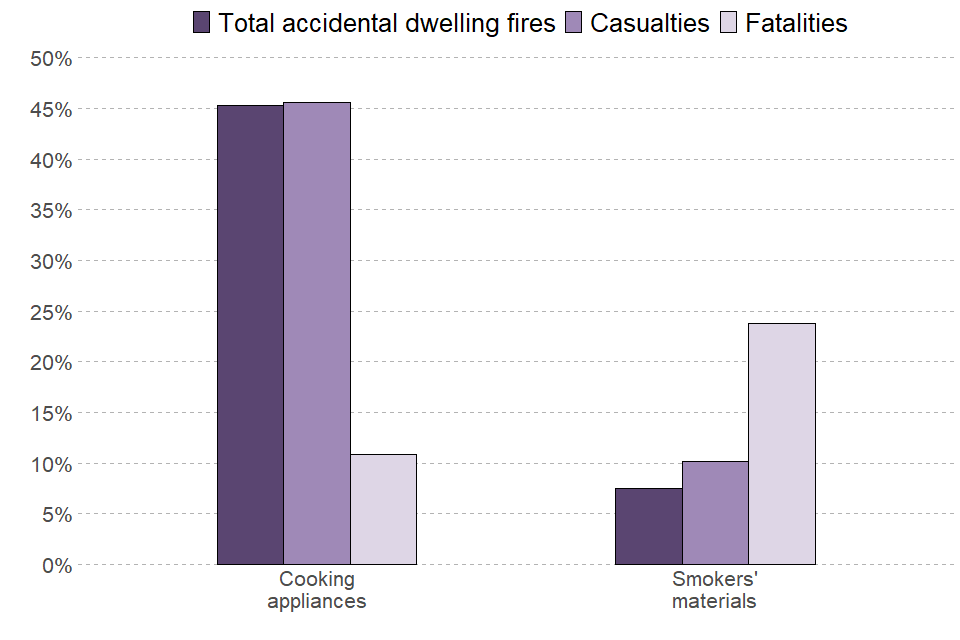
By combining IRS and English Housing Survey data, Home Office statisticians have calculated that you are around nine times more likely to die in a fire if you do not have a working smoke alarm in your home[footnote 1].
As illustrated in the infographic below the fire-related fatality rate per million is higher for men and older people. For men the fatality rate was 5.9 per million population, compared to 3.6 per million population for women. For men aged 65 to 79 the fatality rate was 13.3 per million population while the equivalent rate in the same age group for women was 7.8 per million. For those aged 80 and over, the rate for men was 20.2 per million and for women was 19.3 per million.
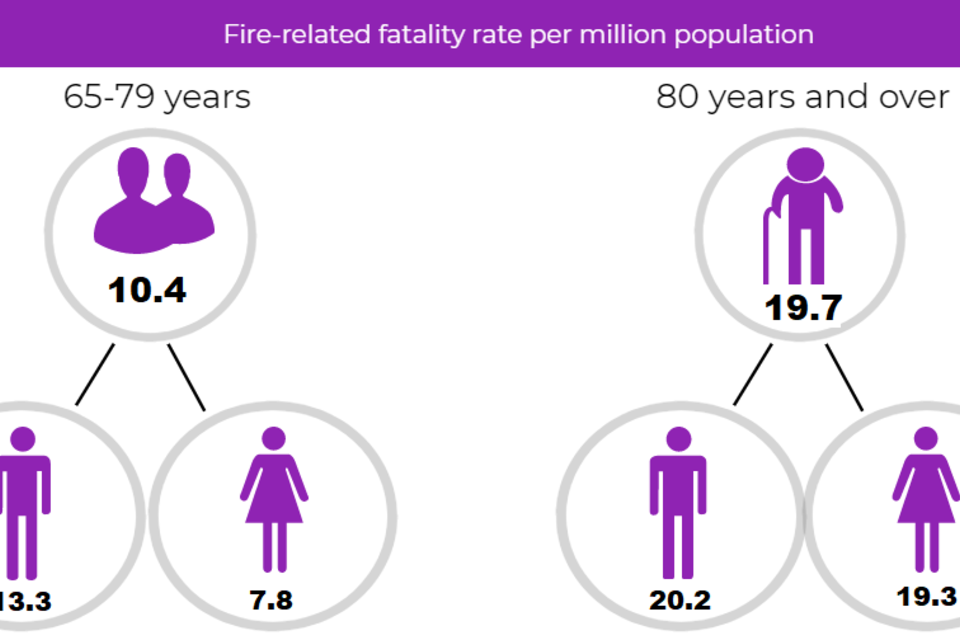
1. Overview of incidents attended
1.1 Key results
In the year ending March 2022:
-
577,053 incidents were attended by FRSs, this was 11 per cent increase compared with the previous year (518,270), three per cent increase compared with five years ago (560,694) and five per cent decrease compared with ten years ago (606,941) Source: FIRE0102
-
the increase in incidents attended this year compared with the previous year was driven by increases in all three main incident types (fires, non-fire incidents and fire false alarms), as restrictions to life due to the coronavirus (COVID-19) pandemic in the previous year may have reduced the number of certain incident types and this should be borne in mind when considering year on year comparisons.
-
of all incidents attended by FRSs, fires accounted for 26 per cent, fire false alarms 40 per cent and non-fire incidents 34 per cent compared with fires accounting for 37 per cent, fire false alarms 41 per cent and non-fire incidents 22 per cent ten years ago Source: FIRE0102
Types of fire as recorded in the Incident Recording System (IRS)
Primary fires Are potentially more serious fires that cause harm to people or damage to property. To be categorised as primary these fires must either:
- occur in a (non-derelict) building, vehicle or outdoor structure
- involve fatalities, non-fatal casualties or rescues
- or be attended by 5 or more pumping appliances
Secondary fires Are generally small outdoor fires, not involving people or property.
Chimney fires Are fires in buildings where the flame was contained within the chimney structure and did not meet any of the criteria for primary fires.
The IRS also captures the motive for a fire, which is recorded as either accidental, deliberate or unknown. Those recorded as unknown are included in the accidental category for the purposes of this report. Accidental fires are therefore those where the motive for the fire was presumed to be accidental or is unknown. Deliberate fires include those where the motive was “thought to be” or “suspected to be” deliberate and includes damage to own or other’s property. These fires are not the same as (although include) arson, which is defined under the Criminal Damage Act of 1971 as “an act of attempting to destroy or damage property, and/or in doing so, to endanger life”.
The Fire and Rescue Incident Statistics publication provides information on a quarterly basis on types of and trends in fires, non-fire incidents and fire false alarms attended by fire and rescue services (FRSs). Key points are included here for background to the following chapters.
1.2 Trends in all incidents
The long term picture shows that the number of incidents attended by FRSs in England peaked in the year to March 2004, at over one million incidents. For around a decade, there was a general decline in all three categories of incidents attended and between the year to March 2013 and the year to March 2016 there were around half a million a year. From the year to March 2016 this number rose to around 577,000 incidents in the year to March 2019 and was around 577,000 in the year ending March 2022.
1.3 Fires attended
The total number of fires attended by FRSs decreased for around a decade - falling by around two thirds from a peak of around 474,000 in the year to March 2004 to around 154,000 in the year to March 2013. The total number of fires has fluctuated since March 2013. The total has subsequently varied between 150,000 and 185,000 with the highest annual figure in the year to March 2019, caused by the hot, dry summer of 2018.
Although the year to March 2021 had the lowest figure recorded since comparable statistics became available in the year to March 1996, restrictions to life throughout the year to March 2021 in response to the COVID-19 pandemic was an element in this relatively low figure. (See Figure 1.1). There was a one per cent increase between the year ending March 2021 and the year ending March 2022 to 152,608.
Table 1: Number of fires, comparing the year ending March 2022 with one, five and ten years previously
| Incident type | 2021/22 | 2020/21 | change | 2016/17 | change | 2011/12 | change |
|---|---|---|---|---|---|---|---|
| Fires | 152,608 | 151,095 | +1% | 162,049 | -6% | 223,937 | -32% |
| Primary fires | 63,482 | 61,911 | +3% | 74,946 | -15% | 86,982 | -27% |
| Dwelling fires | 27,166 | 27,016 | +1% | 30,351 | -10% | 35,417 | -23% |
| Accidental dwelling fires | 24,481 | 24,287 | +1% | 27,246 | -10% | 30,802 | -21% |
| Secondary fires | 86,518 | 86,080 | +1% | 82,862 | +4% | 131,124 | -34% |
Source: Home Office, FIRE0102, FIRE0202
Figure 1.1: Fires attended by type of fire, England; the year ending March 2000 to the year ending March 2022
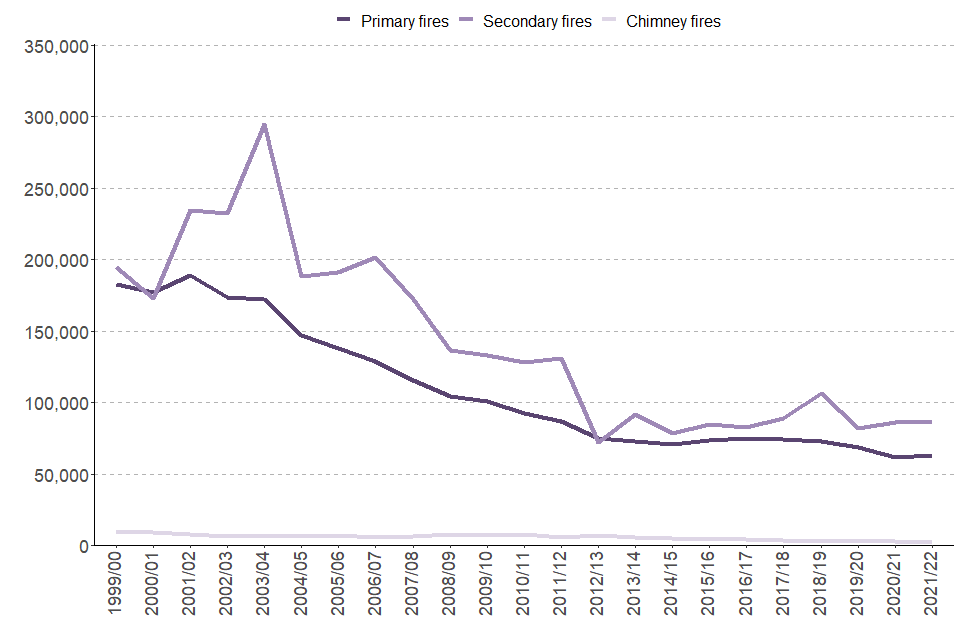
Source: Home Office, FIRE0102
2. Fire-related fatalities, non-fatal casualties, rescues and evacuations
As the Incident Recording System (IRS) is a continually updated database, the statistics published in this release may not match those held locally by FRSs and revisions may occur in the future (see the revisions section for further detail). This may be particularly relevant for fire-related fatalities where a coroner’s report could lead to revisions in the data some time after the incident. It should also be noted that the numbers of fire-related fatalities are prone to year-on-year fluctuations due to relatively low numbers.
2.1 Key results
In the year ending March 2022:
-
there were 272 fire-related fatalities: this figure included 99 fire-related fatalities from the final three months of 2021, which was the highest quarterly figure recorded since April, May and June in 2017 (the quarter the Grenfell Tower fire occurred in) and prior to that the largest since October, November and December in 2008 - the quarterly figure for January to March 2022 is more in line with recent quarterly data than with October to December 2021
-
76 per cent (208) of fire-related fatalities were in dwelling fires
-
there were 4.8 fire-related fatalities for every million people in England and the fatality rate was highest among older people: 10.4 people per million for those aged 65 to 79 years old and 19.7 for those aged 80 years and over (Figure 2.1)
-
the fatality rates for age bands within 54 years and younger were all below four fatalities per million population
-
men had a greater likelihood of dying in a fire than women (5.9 per million population for males compared with 3.6 per million for females)
-
the most common cause of death for fire-related fatalities (where the cause of death was known) was “overcome by gas or smoke”, given in 32 per cent (88) of fire-related fatalities
-
there were 2,794 rescues from primary fires, this was a one per cent increase compared with the previous year (2,760) but a decrease of 13 per cent from five years ago (3,210) and 29 per cent from ten years ago (3,915)
-
there were 4,361 primary fires that involved an evacuation, this was an increase of seven per cent compared with the previous year (4,058) but a decrease of 34 per cent from five years ago (6,592) and 48 per cent from ten years ago (8,353)
Fire-related fatalities are those that would not have otherwise occurred had there not been a fire. For the purpose of publications, a “fire-related” fatality includes those that were recorded as “don’t know”.
Non-fatal casualties are those resulting from a fire, whether the injury was caused by the fire or not.
A rescue is where a person has received physical assistance to get clear of the area involved in the incident.
An evacuation is the direction of people from a dangerous place to somewhere safe.
2.2 Fire-related fatalities and non-fatal casualties by location of fire
In the year ending March 2022, there were 272 fire-related fatalities and 6,307 non-fatal casualties in fires. This compared with 237 fire-related fatalities (an increase of 15 per cent) and 6,362 (a one per cent decrease) in the previous year.
In the last ten years the proportion of fire-related fatalities that were in dwelling fires has been on a very slight upwards trend; from a low of 74 per cent in the year to March 2012 to a peak of 82 per cent in the year to March 2017, after which it plateaued until the year ending March 2020. However, in the past two years the proportion of fire-related fatalities that were in dwelling fires decreased to 78 per cent (185 fire-related fatalities) in the year to March 2021 and then again to 76 per cent (208 fire-related fatalities) in the year to March 2022.
Fire-related fatalities in other buildings showed a decrease compared with the previous year. In the year to March 2022 there were 11 fire-related fatalities in other buildings, a decrease of three from 14 fire-related fatalities in the previous year.
There were 30 fire-related fatalities in purpose built flats or maisonettes in the year ending March 2022 (14 per cent of all dwelling fire-related fatalities), compared to 46 in the previous year (25 per cent of all dwelling fire-related fatalities) and 47 five years ago (22 per cent of all dwelling fire-related fatalities). The proportion of dwelling fire casualties in purpose built flats or maisonettes has been relatively stable over the past decade (varying between 25 and 28 per cent) perhaps reflecting numbers of fire-related fatalities are more prone to year-on-year fluctuations due to lower numbers than with casualties.
Seventy-six per cent (4,765) of non-fatal casualties were in dwelling fires in the year ending March 2022; this is a similar proportion to previous years (77% per cent in the previous year, 76% five years ago and 78% ten years previously).
The number of non-fatal casualties in other buildings was virtually unchanged compared with the previous year (from 748 in the year ending March 2021 to 746 in the year ending March 2022). Non-fatal casualties in other buildings have generally declined over the last six years.
2.3 Fire-related fatalities and non-fatal casualties by gender and age
The likelihood of dying in a fire is not uniform across all age groups or genders. Generally, the likelihood increases with age, with those aged 80 and over by far the most likely to die in a fire. Overall, men are almost twice as likely to die in a fire as women. Although the overall number of fire-related fatalities is relatively low, and so prone to fluctuation, these general patterns have been consistent since data became available in the financial year 2009 to 2010. (Source: FIRE0503)
In the year ending March 2022, 49 per cent of all fire-related fatalities in England (134 fatalities) were 65 years old and over, compared with 19 per cent (1,204) of all non-fatal casualties; these proportions are similar to the previous year, with 46 per cent for all fire-related fatalities and 20 per cent for all non-fatal casualties.
For every million people in England, there were 4.8 fire-related fatalities in the year ending March 2022. The fatality rate was highest among older people: 10.4 people per million for those aged 65 to 79 years old and 19.7 for those aged 80 and over (Figure 2.1). The fatality rates for age bands for 54 years and younger were all below four fatalities per million population.
There were 162 male fire-related fatalities and 104 female in the year ending March 2022, with six recorded as “not known”.
Men have a greater likelihood of dying in a fire than women. The overall fatality rate per million population for males in the year ending March 2022 was 5.9 while the rate for females was 3.6 per million. For men aged 65 to 79 the fatality rate was 13.3 per million while the equivalent rate for women was 7.8 per million. For those aged 80 and over, the rate for men was 20.2 per million and for women was 19.3 per million (Figure 2.2).
Figure 2.1: Fatality rate (fatalities per million people) for all ages and selected age bands, England; the year ending March 2010 to the year ending March 2022

Source: Home Office, FIRE0503a
Figure 2.2: Fatality rate (fatalities per million people) for all ages and selected age bands by gender, England; the year ending March 2022
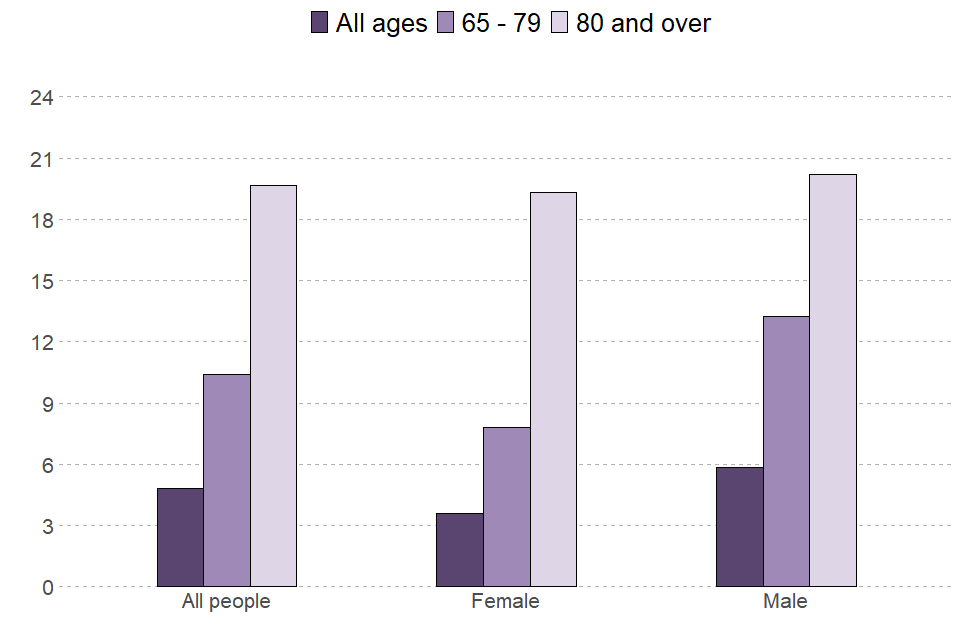
Source: Home Office, FIRE0503a
2.4 Causes of deaths and injuries
The IRS records the cause of death or nature of injury for fire-related fatalities and non-fatal casualties in fires. In the year ending March 2022, where known, the most common cause of death for fire-related fatalities was “overcome by gas or smoke” (recorded for 32 per cent (88) of fire-related fatalities). This has been the most common cause of death for almost every year since the start of the online IRS in the financial year 2009 to 2010. In the year ending March 2022 this was followed by “burns” (31%; 85 fire-related fatalities).
The proportions for causes of death in fire-related fatalities are fairly stable across most years. The exception for this was for the financial year 2017 to 2018 where the “unspecified” category was higher (26% compared with a usual range of between 10-20%) due to the Grenfell Tower fire, where a large proportion of the fatalities are recorded as “unspecified” while the public inquiry into the fire is still ongoing. (Source: FIRE0504)
There were 4,234 non-fatal casualties from accidental dwelling fires in the year ending March 2022, including those who received first aid (1,327) and those who were advised to seek precautionary checks (1,269). When these two groups are removed and only non-fatal casualties requiring hospital treatment (1,638) are looked at, the largest category of injury was “overcome by gas or smoke” (782; 48%) followed by “burns” (393; 24%) and “other breathing difficulties” (208; 13%). All the other categories combined comprised the remaining 16 per cent of injuries. (Source: FIRE0506)
2.5 Rescues and evacuations
The IRS records the exact number of people rescued from primary fires attended by FRSs. The number of people rescued from primary fires attended by FRSs has generally been on a downward trend since the online IRS was introduced, decreasing from around 4,400 in the year ending March 2010 to around 2,800 in the year ending March 2022 (Figure 2.3). This change has been driven by a decrease in all rescue types.
In the year ending March 2022, there were 2,794 people rescued from primary fires. This was a one per cent increase compared with the previous year (2,760) but a decrease of 13 per cent from five years ago and 29 per cent compared to ten years previously. In the year ending March 2022, over three quarters (79%) of rescues were from primary dwelling fires with other building, road vehicle and other outdoor fires accounting for 15 per cent, five per cent and one per cent, respectively.
Figure 2.3: Number of people rescued from primary fires, England; the year ending March 2010 to the year ending March 2022
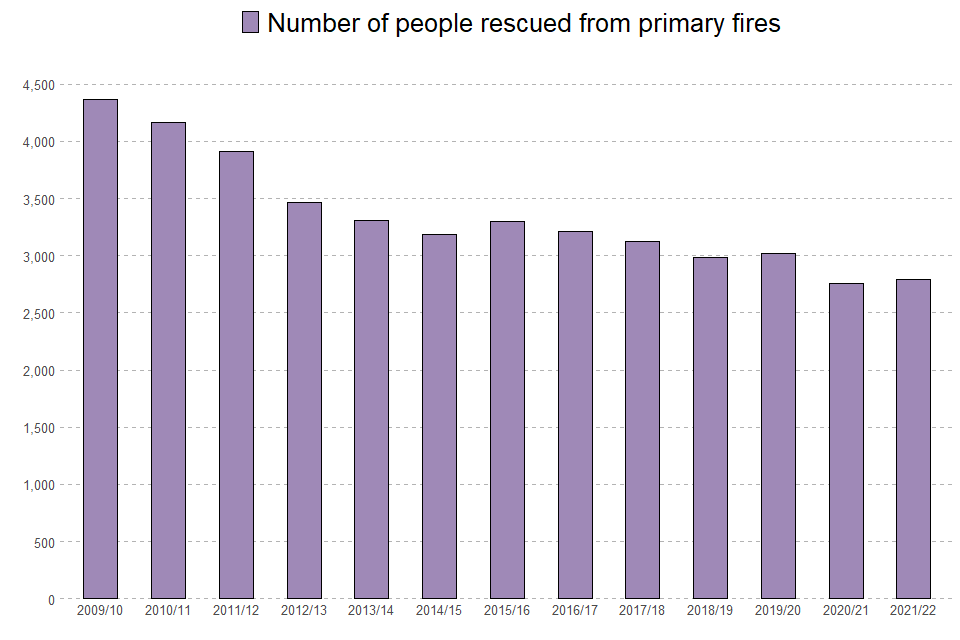
Source: Home Office, FIRE0511
For evacuations from fires attended by FRSs, the IRS records how many people were assisted in eight separate bands (e.g. 6-20 means there were between 6 and 20 people evacuated from a fire). The number of primary fires attended that involved an evacuation has also generally been on a downward trend (Figure 2.4), decreasing from around 9,300 in the year ending March 2010 to around 4,400 in the year ending March 2022. This decrease has been driven by decreases in all types of evacuations.
In the year ending March 2022, there were 4,361 primary fires that involved an evacuation. This was an increase of seven per cent compared with the previous year (4,058) but a decrease of 34 per cent from five years ago and 48 per cent compared to ten years ago.
The most common evacuation band was “1 to 5” (i.e. there were 1 to 5 people evacuated from the fire), accounting for 88 per cent of primary fires that involved an evacuation. (Source: FIRE0511)
Figure 2.4: Number of primary fires with an evacuation, England; the year ending March 2010 to the year ending March 2022
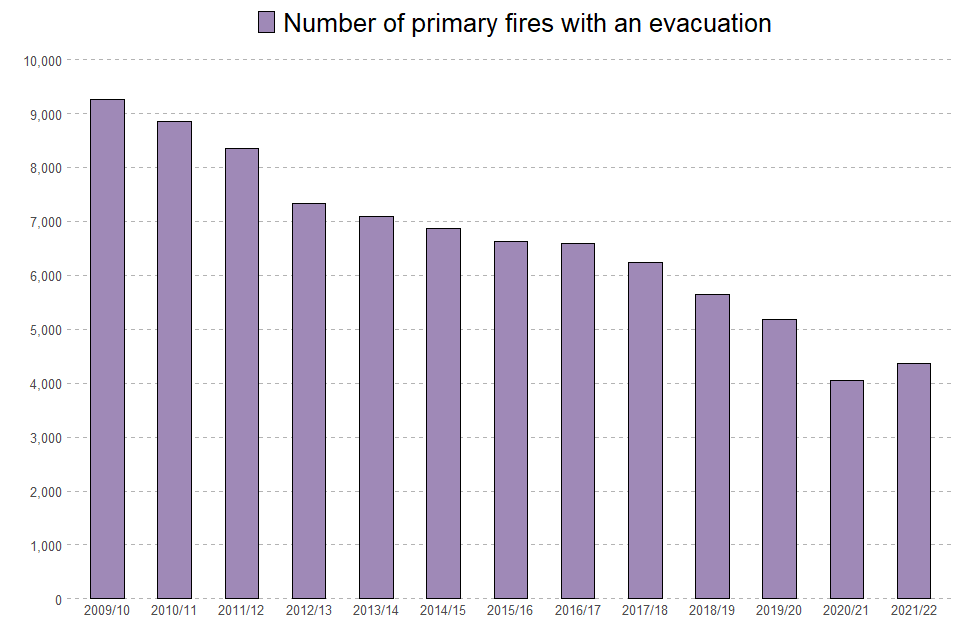
Source: Home Office, FIRE0511
The increases for rescues and evacuations compared to the previous years can in part be explained by the restrictions on life throughout the year ending March 2021 in response to the COVID-19 pandemic (see “Rescues and evacuations attended under COVID-19 national lockdowns in Detailed analysis of fires attended by fire and rescue services, England, April 2020 to March 2021)”.
3. Extent of damage and spread of fire
The IRS also records the extent of damage and the spread of fire. The extent of damage (due to smoke, heat, flame and water etc.) to dwellings and other buildings is recorded by the area in square metres broken down into thirteen categories, from “None” up to “Over 10,000” square metres[footnote 2]. The spread of fire in dwellings and other buildings is recorded according to the extent the fire reached different parts of the building based on eight categories from “no fire damage” to “fire spread to the whole building”.
3.1 Key results
In the year ending March 2022:
-
the average area of damage to dwellings (excluding those over 5,000m2) in England was 14.2m2, a decrease of four per cent compared with the previous year, a decrease of 17 per cent from five years ago (17.1m2) and a 32 per cent decrease from ten years ago (20.8m2)
-
the average area of damage to other buildings (excluding those over 1,000m2) decreased by 16 per cent to 24.1m2 compared with 28.8m2 in the year ending March 2021 - this was a decrease of 17 per cent from five years ago (29.2m2) and a decrease of 27 per cent from ten years ago (33.1m2)
-
six per cent of fires in purpose-built high-rise (10+ storeys) flats or maisonettes spread beyond the room of origin, compared with eight per cent of fires in purpose-built medium-rise (4-9 storeys) flats or maisonettes, ten per cent in purpose-built low-rise (1-3 storeys) flats or maisonettes and 13 per cent of fires in houses, bungalows, converted flats and other dwellings combined. These percentages are broadly in line with previous years.
3.2 Extent of damage
Dwelling fires with more than 5,000m2 of damage and other buildings fires with more than 1,000m2 of damage can skew the averages, so were removed for the averages reported here. However, for completeness, other calculations are available in tables FIRE0204 and FIRE0305, which accompany this release. It should be noted that excluding these area categories removed four dwelling fires (approximately 0.01% of all dwelling fires) and 146 other buildings fires (approximately one per cent of all other building fires) for the year ending March 2022.
The average extent of damage to dwellings has generally fallen since the year ending March 2004. In the year ending March 2022, the average area of damage to dwellings (excluding those over 5,000m2) in England was 14.2m2. This was a four per cent decrease compared with the previous year, a 17 per cent decrease on five years ago and a 32 per cent decrease compared to ten years ago. (Source: FIRE0204)
The average extent of damage to other buildings has fluctuated since the year ending March 2010 (from when the average extent of damage to other buildings started being more accurately recorded)[footnote 3], although the figure recorded for average area of damage to other buildings (excluding those over 1,000m2) in the year ending March 2022 was the lowest figure since comparable data became available. The average area of damage to other buildings (excluding those over 1,000m2) decreased by 16 per cent to 24.1m2, compared with 28.8m2 in the year ending March 2021 - this was a decrease of 17 per cent from five years ago (29.2m2) and a decrease of 27 per cent from ten years ago (33.1m2). (Source: FIRE0305)
3.3 Spread of fire
In the year ending March 2022, nearly one third (30%) of dwelling fires had no fire damage, in around a third (33%) the damage was limited to the item first ignited and in roughly a quarter (24%) the damage was limited to the room of origin. The remaining 14 per cent of dwelling fires were larger fires, either “limited to floor of origin”, “limited to 2 floors”, “affecting more than 2 floors”, “limited to roofs and roof spaces” or the “whole building”. (Source: FIRE0203)
Six per cent of fires in purpose-built high-rise (10 or more storeys) flats or maisonettes spread beyond the room of origin[footnote 4], compared to eight per cent in purpose-built medium-rise (4-9 storeys) flats or maisonettes and ten per cent in purpose-built low-rise (1-3 storeys) flats or maisonettes. These relatively similar figures compared to 13 per cent in houses, bungalows, converted flats and other dwellings combined. These figures were all similar to previous years.
Only two per cent of dwelling fires affected the “whole building” in the year ending March 2022, similar to previous years. Between the year ending March 2012 and the year ending March 2022, the proportion of dwelling fires that were “limited to item first ignited” has been on a slowly increasing trend from 28 per cent to 33 per cent. Over the same time period, the percentage of dwelling fires that had no fire damage has been on a slowly decreasing trend from 32 per cent to 30 per cent.
In contrast, in the year ending March 2022, the proportion of other building fires affecting the “whole building” was 15 per cent compared to 20 per cent in the previous year, 14 per cent five years ago and 16 per cent ten years ago.
Between the year ending March 2012 and the year ending March 2022 the proportion of other building fires that were “limited to item first ignited” has fluctuated between 26 and 29 per cent (28% in the year ending March 2022) and the percentage of other building fires that had no fire damage has varied between 20 and 27 per cent, it was 23 per cent in the year ending March 2022. (Source: FIRE0304)
4. Causes of dwelling fires and fire-related fatalities
The IRS collects information on the source of ignition (e.g. “smokers’ materials”), the cause of fire (e.g. “fault in equipment or appliance”), which item or material was mainly responsible for the spread of the fire (e.g. “clothing or textiles”), and ignition power (e.g. gas)[footnote 5].
4.1 Key results
In the year ending March 2022:
-
cooking appliances were the largest ignition category for accidental dwelling fires, accounting for 45 per cent of these fires and 46 per cent of non-fatal casualties but only 11 per cent of the fire-related fatalities
-
smokers’ materials were the source of ignition in seven per cent of accidental dwelling fires and ten per cent of accidental dwelling fire non-fatal casualties, but were the largest ignition category (except “other/unspecified”) for fire-related fatalities in accidental dwelling fires, accounting for 24 per cent
-
of the 24,541 accidental dwelling fires[footnote 6], 31 per cent were caused by “misuse of equipment or appliances”, virtually unchanged from the year ending March 2021
4.2 Sources of ignition in accidental dwelling fires
Since the year ending March 2012, the number of accidental dwelling fires has decreased by 21 per cent. This was in large part driven by a 29 per cent decrease (between the year ending March 2011 and the year ending March 2022) in fires where the ignition source was “cooking appliance”, as these make up nearly half of all accidental dwelling fires. Other ignition types that have contributed to the decrease include “space heating appliance” and “other electrical appliance” (decreases of 33% and 27% over the same time period, respectively). (Source: FIRE0602)
Figure 4.1 shows the proportion of accidental dwelling fires, and their resulting non-fatal casualties and fire-related fatalities, attributable to different sources of ignition[footnote 7]. It shows that while some ignition sources cause many fires, they often result in relatively few fire-related fatalities, and vice versa. (Source: FIRE0601 to FIRE0605)
Figure 4.1: Percentage of fires, non-fatal casualties and fire-related fatalities in accidental dwelling fires by selected sources of ignition, England; year ending March 2022
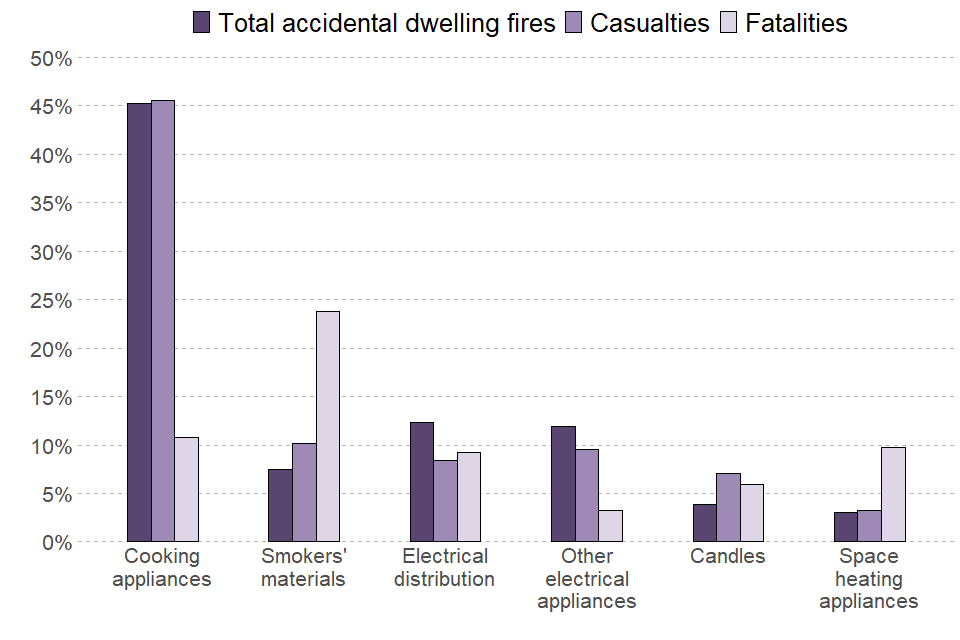
Source: Home Office, FIRE0602
4.3 Main cause of, and material mainly responsible for, dwelling fires
Exactly how a fire originated, and then the material which was mainly responsible for it spreading, are both important determinants in the outcomes of fires. Notably, and similarly to sources of ignition, the most common causes and materials responsible for the spread of fires are not those that lead to the greatest proportion of fire-related fatalities.
Of the 24,541 dwelling fires with accidental causes in the year ending March 2022, 31 per cent were caused by “misuse of equipment or appliance” (Figure 4.2), virtually unchanged compared to the previous year (31%). The second largest cause category was “faulty appliances and leads” which caused 15 per cent of all accidental dwelling fires. (Source: FIRE0601)
The material mainly responsible for the development of the fire in 24 per cent of all dwelling fires and the item first ignited in 27 per cent of all dwelling fires in the year ending March 2022 was “Textiles, upholstery and furnishings”. This material was mainly responsible for 58 per cent of all fire-related fatalities in dwellings. (Source: FIRE0603, FIRE0604)
“Food” was the material mainly responsible for the development of the fire in 17 per cent of all dwelling fires and the item first ignited in 25 per cent of all dwelling fires in the year ending March 2022. However, it was the material mainly responsible for the development of the fire in only four per cent of all fire-related fatalities in dwelling fires.
Figure 4.2: Percentage of fires in accidental dwelling fires by cause of fire, England; year ending March 2022
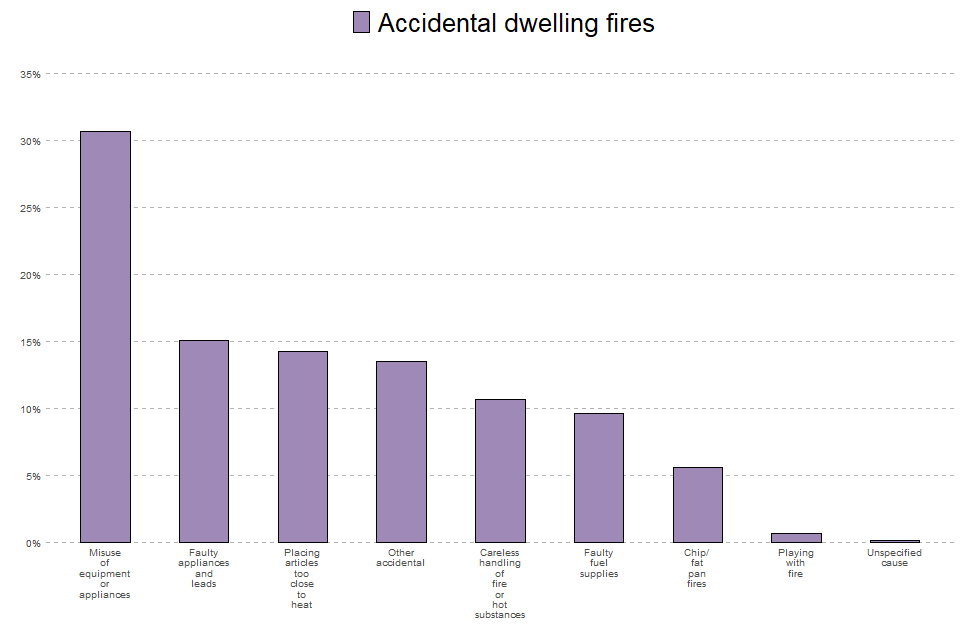
Source: Home Office, FIRE0601
5. Temporal and seasonal fire analyses
5.1 Key results
In the year ending March 2022:
-
the hourly number of fires showed a strong daily pattern, with almost half (49%) of all fires occurring where the time of call was between 16:00 and 22:00
-
the hourly number of fire-related fatalities did not show a daily pattern, with the number of fire-related fatalities roughly equal between day and night hours
-
April experienced the most fires per day attended by FRSs (an average of 747), whilst December had the fewest (280 fires per day on average)
-
the average numbers of fires attended per day over the whole year (418) was almost the same as the previous year (414)
Fires and fire-related fatalities are affected by both seasonality and time of day. Similar to previous years, there were generally fewer fires where the time of call was between midnight and 11am, but the number of fire-related fatalities remained relatively high despite lower incidence of fires and with no strong temporal pattern. Additionally, little seasonality was evident in dwelling, other building and road vehicle fires, while outdoor fires and chimney fires showed much stronger seasonal effects.
5.2 Temporal fire analyses
49 per cent of all fires in the year ending March 2022 occurred where the time of call was between 16:00 and 22:00 (Figure 5.1). These were the six individual hours with the highest proportion of fires (by time of call), which was also true for all the previous financial years. The peak hours were between 18:00 and 21:00 and accounted for at least 8.5 per cent of fires each in the year ending March 2022, similar to previous years. (Source: FIRE0801)
Figure 5.1 Percentage of fires and fire-related fatalities by hour of the day, England; the year ending March 2022

Source: Home Office, FIRE0801
In contrast to the number of fires, the hourly number of fire-related fatalities showed less of a pattern across the day in the year ending March 2022, so, as in previous years, fire-related fatalities were roughly equal between day and night hours. The peak hours were 20:00-21:00 (7.4%), 12:00-13:00 (6.3%) and 02:00-03:00 (6.3%). While the six individual hours with the highest proportion of fires were continuous and accounted for 49 per cent of incidents, the six hours with the highest proportion of fatalities were spread throughout the day and accounted for just 35 per cent (Figure 6.1) of fatalities.
5.3 Seasonal fire analyses
Very little seasonality was evident in dwelling, other building and road vehicle fires, however outdoor fires and chimney fires showed much stronger seasonal effects. There tends to be more grassland, refuse and other outdoor fires in the summer months and these seem to reflect weather patterns (see FIRE0802). Conversely, chimney fires are more numerous in the winter months. These seasonal effects are broadly similar each year but are affected by changes in weather patterns specific to that year, e.g. in the year ending March 2022 the values were skewed towards spring with a peak in April while in the previous year they were highest in May.
The high rate of fires in April 2021 was driven by fires in “grassland, woodland and crops”, which had a daily rate over double than any other month (224 fires per day, compared with 106 in March). Moreover, refuse fires, other outdoor and secondary fires, dwelling fires and other building fires all recorded their highest rate that month.
The daily rate of all fires for the year ending March 2022 was 418 fires per day. Almost two thirds (60%) of these were all types of outdoor fires.
Fires in dwellings, other buildings and road vehicles showed relatively little seasonality, with a slight increase in spring months, and the daily rate of these fires attended varied between 149 and 180 per month in the year ending March 2022.
Figure 5.2 shows the average daily number of different types of fires in the year ending March 2022. It shows how stable dwelling, other building and road vehicle fires are across months, compared with seasonal outdoor fires and, to a lesser extent, chimney fires.
Figure 5.2: Average daily fire incidents by month and location, England; the year ending March 2022
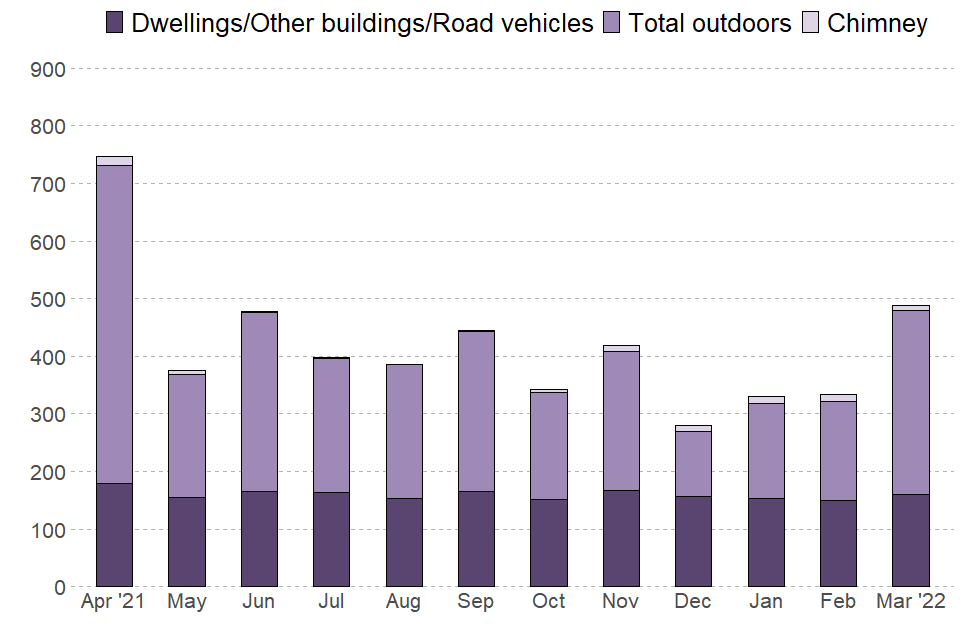
Source: Home Office, FIRE0802
6. Smoke alarm function
6.1 Key results
In the year ending March 2022:
-
fires where a smoke alarm was not present accounted for 24 per cent (6,449) of all dwelling fires and 37 per cent (76) of all dwelling fire-related fatalities
-
mains powered smoke alarms continued to have a lower “failure rate” than battery powered smoke alarms; 21 per cent of mains powered smoke alarms failed to operate in dwelling fires compared with 36 per cent of battery powered smoke alarms
The IRS records information on whether a smoke alarm was present at the fire incident, as well as the type of alarm (mains or battery powered) and whether or not it functioned as intended i.e. if it operated and if it raised the alarm.
6.2 Smoke alarms in dwelling fires
Reasons alarms did not function as expected
Did not operate Alarm battery missing; alarm battery defective; system not set up correctly; system damaged by fire; fire not close enough to detector; fault in system; system turned off; fire in area not covered by system; detector removed; alerted by other means; other; not known.
Operated but did not raise the alarm No person in earshot; occupants did not respond; no other person responded; other; not known.
Fires where a smoke alarm was present but either did not operate or did not raise the alarm accounted for just under a third (31%) of all dwelling fires in the year ending March 2022, one percentage point lower than in the year ending March 2021.
In the year ending March 2022, “fire products did not reach detector(s)”[footnote 8] and “fire in area not covered by system” accounted for 66 per cent of smoke alarm failures in dwelling fires where the smoke alarm was mains powered (Table 2). Similarly, the main reasons smoke alarms failed to operate in dwelling fires with battery operated smoke alarms present were “fire products did not reach detector(s)” and “fire in area not covered by system” (61% in the year ending March 2022). These were also the principal causes of smoke alarm failures in recent years.
As for all years since the year ending March 2011, in the year ending March 2022 the most common category of smoke alarm failure in dwelling fires involving any casualties was “Other” (including “alerted by other means”, “system damaged by fire”, “other” and “don’t know”), which accounted for 33 per cent of these fires where battery powered smoke detectors were present and 32 per cent where mains powered detectors were present. (Source: FIRE0704)
Table 2: Reason smoke alarms did not operate in dwelling fires and dwelling fires resulting in casualties, by type of alarm, England, year ending March 2022
| Reason for failure | Battery powered - fires | Battery powered - fire resulting in casualties | Mains powered - fires | Mains powered - fire resulting in casualties |
|---|---|---|---|---|
| Missing battery | 8% | 13% | 0% | 3% |
| Defective battery | 9% | 11% | 0% | 5% |
| Other act preventing alarm from operating | 2% | 9% | 6% | 24% |
| Fire products did not reach detector(s) | 46% | 13% | 50% | 14% |
| Fire in area not covered by system | 15% | 7% | 16% | 8% |
| Faulty system / incorrectly installed | 3% | 15% | 4% | 14% |
| Other | 18% | 33% | 24% | 32% |
Notes:
-
Includes all non-fatal casualties and fire-related fatalities.
-
Mains powered smoke alarms includes those recorded as “mains and battery” in the IRS, therefore there are a small number of mains powered smoke alarms where the reason for failure is “missing battery” or “defective battery”.
6.3 Smoke alarm function and outcomes
Figure 6.1 shows the proportion of dwelling fires and fire-related fatalities in dwelling fires where the alarm was “present, operated and raised the alarm”, “present but did not raise the alarm”, “present but did not operate” or “absent”. It shows that a smoke alarm was present and raised the alarm (i.e. functioned as intended) in 45 per cent of dwelling fires in the year ending March 2022 but in only 28 per cent of fire-related fatalities, highlighting the importance of both having working smoke alarms and having enough of them to cover all areas in a dwelling. In the year ending March 2021, according to the English Housing Survey, 94 per cent of households had a working smoke alarm. (Source: FIRE0701, FIRE0702)
Alarms were absent in a higher proportion for fire-related fatalities (37%) than in dwelling fires (24%) in the year ending March 2022. This pattern is consistent with previous years.
Figure 6.1: Smoke alarm operation outcomes in dwelling fires and fire-related fatalities, England; in the year ending March 2022
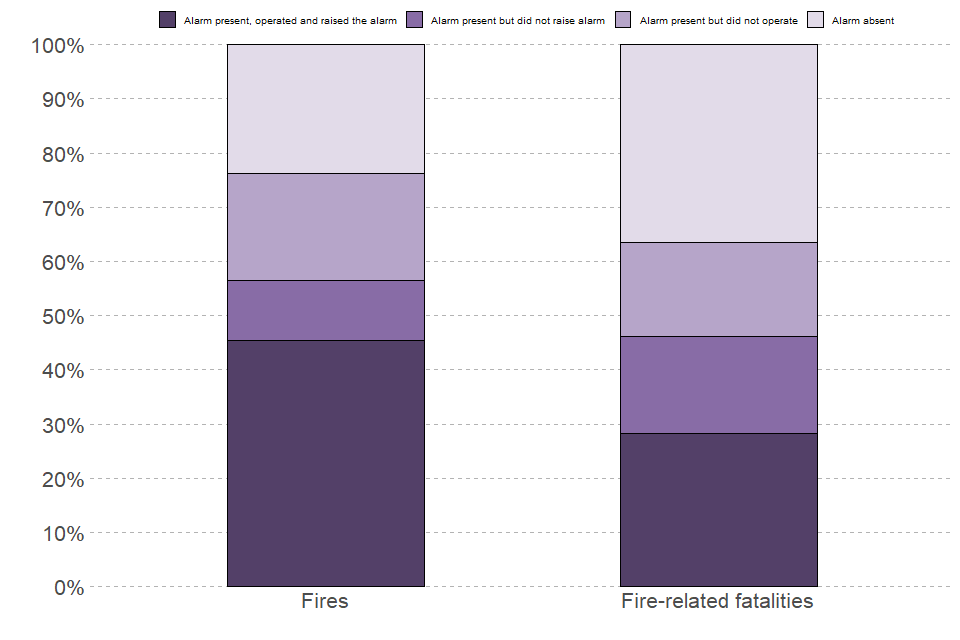
Source: Home Office, FIRE0702
By combining IRS and English Housing Survey data, Home Office statisticians have calculated that you are around nine times more likely to die in a fire if you do not have a working smoke alarm in your home[footnote 1].
6.4 Smoke alarms in other building fires
Fires where a smoke alarm was not present accounted for 48 per cent of all other building fires in the year ending March 2022. This has been relatively stable since the year ending March 2013; with the percentage fluctuating between 45 per cent and 48 per cent. However, likely due to the COVID-19 pandemic, in the year to March 2021 the highest figure since comparable data became available in the year to March 2011 (55%) was recorded. (Source: FIRE0706)
Fires where a smoke alarm was not present accounted for 41 per cent of all other building fire-related fatalities and non-fatal casualties (combined) in the year ending March 2022, eight percentage points fewer than in the previous year. However, it should be noted that due to the relatively small numbers involved this figure is prone to fluctuation and the figure for the year ending March 2021 (49%) was the highest since comparable data became available in the year ending March 2011. (Source: FIRE0706)
Fires where a smoke alarm was present but did not raise the alarm accounted for five per cent, and fires where an alarm was present but did not operate accounted for 11 per cent of other building fires in the year ending March 2022. These proportions have been relatively stable since comparable data became available in the year to March 2011. (Source: FIRE0706)
7. Further information
This release contains statistics about incidents attended by fire and rescue services (FRSs) in England. The statistics are sourced from the Home Office’s online Incident Recording System (IRS). This system allows FRSs to complete an incident form for every incident attended, be it a fire, a false alarm or a non-fire incident (also known as a Special Service incident).
Fire and Rescue Incident Statistics and other Home Office statistical releases are available via the Statistics at Home Office pages on the GOV.UK website.
Data tables linked to this release and all other fire statistics releases can be found on the Home Office’s Fire statistics data tables page.
Guidance for using these statistics and other fire statistics outputs, including a Quality Report, is available on the fire statistics guidance page.
The information published in this release is kept under review, taking into account the needs of users and burdens on suppliers and producers, in line with the Code of Practice for Statistics. The Office for Statistics Regulation recently carried out a compliance check of the Home Office’s fire and rescue incident statistics against the Code of Practice and the results can be found in a letter to the Home Office’s Head of Profession published on the OSR website.
If you have any comments, suggestions or enquiries, please contact the team via email using firestatistics@homeoffice.gov.uk.
7.1 Revisions
The IRS is a continually updated database, with FRSs adding incidents daily. The figures in this release refer to records of incidents that occurred up to and including the end of March 2022. This includes incident records that were submitted to the IRS by 29 June 2022, when a snapshot of the database was taken for the purpose of analysis. As a snapshot of the dataset was taken on 29 June 2022, the statistics published may not match those held locally by FRSs and revisions may occur in the future. This is particularly the case for statistics with relatively small numbers, such as fire-related fatalities. For instance, this can occur because coroner’s reports may mean the initial view taken by the FRS will need to be revised; this can take many months, even years, to do so.
7.2 COVID-19 and the impact on the IRS
The figures presented in this release relate to incidents attended by FRSs during year ending March 2022.
In response to the coronavirus pandemic, restrictions in England, Scotland and Wales started from 12 March 2020. In England three lockdowns which applied strict limits on daily life were imposed. A first lockdown was applied on 23 March 2020 and was eased from 15 June 2020, a second lockdown began on 5 November 2020 and ended on 2 December 2020 and the third began on 4 January 2021 and ended on 12 April 2021. The restrictions and lockdowns are therefore captured in IRS data for this year and the comparator year.
Extra analyses on fire and rescue incidents during this period can be found in the year to March 2021 edition of this release, detailed analysis of fires attended by fire and rescue services, England, April 2020 to March 2021 and detailed analysis of non-fire incidents: England, April 2020 to March 2021.
7.3 Other related publications
Home Office publish five other statistical releases covering fire and rescue services.
These include:
-
Fire and rescue incident statistics, England: provides summary statistics on all incidents attended by fire and rescue services in England, fire-related fatalities, casualties from fires and response times to fires, with long term comparisons, updated quarterly
-
Detailed analysis of non-fire incidents attended by fire and rescue services, England: focuses on non-fire incidents attended by fire and rescue services across England, including analysis on overall trends, fatalities and non-fatal casualties in non-fire incidents, and further detailed analysis of different categories of non-fire incidents
-
Fire and rescue workforce and pensions statistics: focuses on total workforce numbers, workforce diversity and information regarding leavers and joiners; covers both pension fund income and expenditure and firefighters’ pension schemes membership; and includes information on incidents involving attacks on firefighters
-
Fire prevention and protection statistics, England: focuses on trends in smoke alarm ownership, fire prevention and protection activities by fire and rescue services
-
Response times to fires attended by fire and rescue services, England: covers statistics on trends in average response times to fires attended by fire and rescue services
The Department for Levelling Up, Housing and Communities also publish statistical releases on fire including the English housing survey which focuses on the extent to which the existence of fire and fire safety features vary by household and dwelling type
Fire statistics are published by the other UK nations:
Scottish fire statistics and Welsh fire statistics are published based on the IRS. Fire statistics for Northern Ireland are published by the Northern Ireland Fire and Rescue Service using data from a system similar to the Incident Recording System, which means that they are not directly comparable to English, Welsh and Scottish data.
7.4 National Statistics
These statistics have been assessed by the UK Statistics Authority to ensure that they continue to meet the standards required to be designated as National Statistics. This statistical bulletin is produced to the highest professional standards and is free from political interference. It has been produced by statisticians working in accordance with the Home Office’s Statement of compliance with the Code of Practice for Official Statistics, which covers Home Office policy on revisions and other matters. The Chief Statistician, as Head of Profession, reports to the National Statistician with respect to all professional statistical matters and oversees all Home Office National Statistics products with respect to the Code, being responsible for their timing, content and methodology. This means that these statistics meet the highest standards of trustworthiness, impartiality, quality and public value, and are fully compliant with the Code of Practice for Statistics.
-
For details of the calculation and assumptions made, see the definitions document. ↩ ↩2
-
For a list of the damaged area size bands, see the Fire Statistics Definitions document. ↩
-
For detail on the discontinuity between the financial year 2008 to 2009 and the financial year 2009 to 2010 please see page 17 in the financial year 2011 to 2012 incidents response times report ↩
-
Fire spread beyond the room of origin comprises the following IRS categories: where the spread of fire was limited to the floor of origin, where the spread of fire was limited to 2 floors, where the spread of fire was affecting more than 2 floors and where the fire spread to the whole building. ↩
-
For a more detailed definition on the different types of cause of fire, see the definitions document and IRS Guidance. ↩
-
As defined by cause of fire. Source: FIRE0601 ↩
-
This excludes “Other/Unspecified”. ↩
-
Fire products did not reach detectors(s) can be where the smoke alarms present were poorly sited (e.g. not on the floor of origin) so the smoke did not reach the detector. ↩
